Noise and vibration analyzer (Sound level meter) adopts digital signal processing technology and modular design. It has the advantages of large measurement range, low power consumption, small size, etc. It is reliable and stable in long-term operation. It complies with the relevant requirements of GB/T 3785.1-2010 and IEC 61672-1:2013 standards. It complies with the relevant requirements of GB/T 3785.1-2010 and IEC 61672-1:2013 standards.
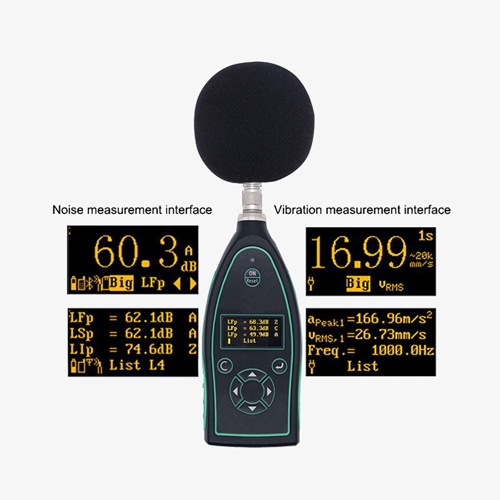
Digital Signal Processing with Auto Switching & Spectrum Analysis
- Adopts digital signal processing technology.
- Supports 1/30 octave band spectrum analysis with integration/handheld transmission.
- Supports real-time synchronous calculation of multiple measurement indicators, allowing automatic switching between noise and vibration measurements when replacing sensors without the need for recalibration.
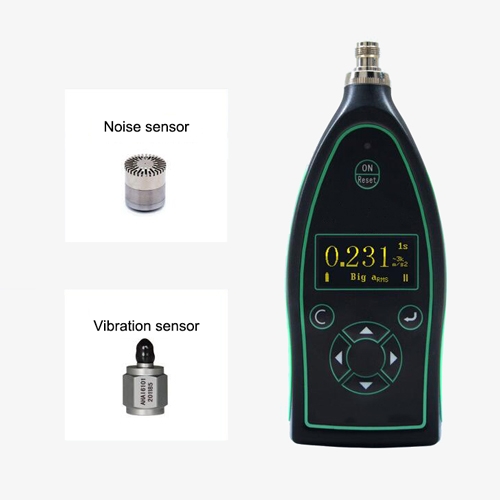
Ergonomic Design with Multi-Weighting and Optional Spectrum Analysis
- Simultaneously performs three types of frequency and time weightings.
- Optional real-time spectrum analysis function available.
- Ergonomically designed streamlined shape provides a comfortable grip and minimizes impact on the sound field.
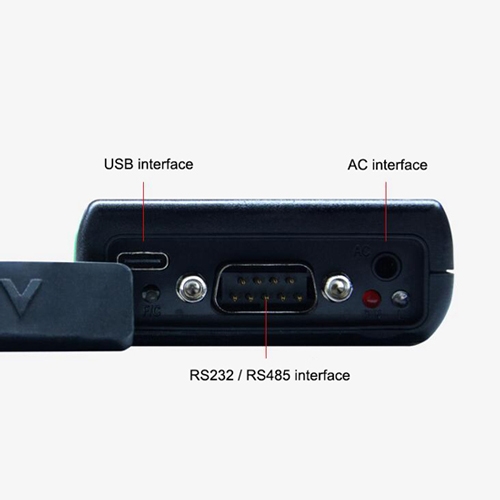
Certified with Bluetooth/RS232/485 Interfaces and Low-Light Operation
- Bluetooth/RS232/485 interfaces with both DC and AC output options.
- Obtained type approval certificate for measuring instruments (sound level meter).
- Designed for low-light conditions: Allows for accurate measurement in low-light or nighttime conditions, ensuring safer and more efficient use.
Applications
SISCO decibel meter are mainly used in various noise monitoring and surveillance occasions, such as automatic monitoring of urban environmental noise, traffic noise monitoring, airport noise monitoring, online monitoring of noise pollution sources (such as construction sites, factory boundaries, road vehicles, etc.), online monitoring of workplaces, etc. It can be used for short-term monitoring or long-term fixed-point monitoring. It can be networked independently or easily integrated into various existing environmental monitoring systems.
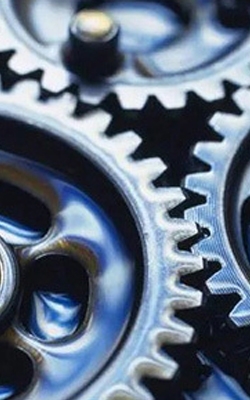
Gearboxes
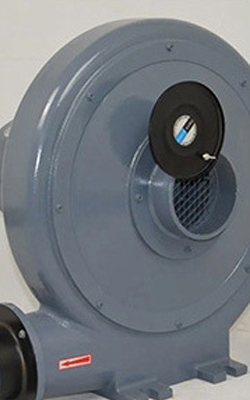
Fans
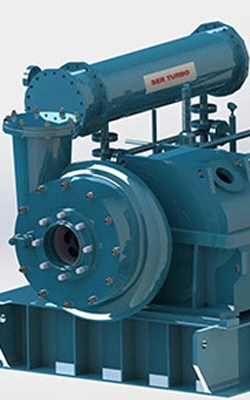
Compressors
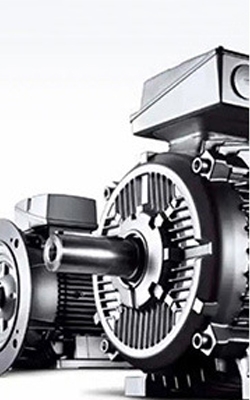
Motors
| Model | SISCO-SLM-3002-2AV | |||
| Noise Performance | ||||
| Microphone | AHAI5221 prepolarization test capacitor microphone | |||
| Measuring Range | 25dB (A) ~ 141dB (A) Note: The measurement range is related to the sensitivity level of the microphone. This range is measured when the microphone sensitivity level is -34.0dB. The measurement lower limit can be below 17dB when equipped with a 1-inch microphone |
|||
| Frequency Range | 20Hz~12.5kHz | |||
| Weighting | Frequency weighting: parallel A, C, Z weighting; Time weighting: parallel F (fast), S (slow), I (impulse) |
|||
| Basic Functions | Lp, Leq,t, Leq,T, Lmax, Lmin, Lpeak, SEL, etc. | |||
| Accuracy | Complies with GB/T3785.1-2010/IEC61672-1: 2013 Level 2; Complies with GB/T3241-2010/IEC61260-1: 2014 Level 2; Personal sound exposure meter accuracy: Complies with GB/T15952-2010/EC61250: 2002 |
|||
| Conditions of Use | Temperature: -10℃~50℃; Relative humidity: 25%~90%; Air pressure: 65kPa~108 kPa | |||
| Data Storage | 4MB Flash RAM | |||
| Other Storage | 8 sets of parameter templates, 128 measurement point names, 64 calibration records | |||
| Power Consumption | <80 mA/5 V | |||
| Vibration Function | ||||
| Frequency Range | Sampling Frequency | Acceleration Gear | Speed Gear | Displacement Gear |
| 8kHz | 10Hz~2.5kHz | 10Hz~1.25kHz | 10Hz~800Hz | |
| 32kHz | 32Hz~13kHz | 32Hz~5.0kHz | 32Hz~2.0kHz | |
| Measuring Range | Sampling Frequency | Peak Acceleration (RMS*√2,m/s2) | Speed Effective Value (mm/s) | Peak-to-Peak Displacement (RMS*2√2, mm) |
| 8kHz | 0.03~1400 | 0.1~2000 | 0.03~12 | |
| 32kHz | 0.03~1400 | 0.1~2000 | 0.002~12 | |
| Main Measurement Indicators | Apeak, arms, app, vpeak, vrms, vpp, dpeak, drms, dpp, VLa,T, amax, vmax, dmax, Vlamax, amin, vmin, dmin, VLamin, frequency indication. | |||
| Manual Vibration Measurement (optional) | Measuring range: 80dB~186dB (Note: 106m/S2 is referenced to 0dB) Frequency range: (reference point: 80Hz, 10m/s2) 8~1000Hz±1dB; 5~1600Hz±2dB Main measuring indicators: awh,4h, VLwh,r, VLwh.max, VLwh.min |
|||
| Recording | Sampling interval can be set from 1 second to 600 seconds | |||
| Optional Features | ||||
| 1/1 OCT Spectrum Analysis Function (optional) |
Filter type: parallel (real-time) octave, base 10, G=103/10; |
|||
| 1/3 OCT Spectrum Analysis Function (optional) | Comply with GB/T 3241-2010; Filter type: Parallel (real-time) octave, base 10, G=103/10; 32 kHz sampling freq: 16 Hz, 20 Hz, 25 Hz, 31.5 Hz, 40 Hz, 50 Hz, 63 Hz, 80 Hz, 100 Hz, 125 Hz, 160 Hz, 200 Hz, 250 Hz, 315 Hz, 400 Hz, 500 Hz, 630 Hz, 800 Hz, 1k Hz, 1.25kHz, 1.6kHz, 2kHz, 2.5kHz, 3.15kHz, 4kHz, 5kHz, 6.3kHz, 8kHz, 10kHz; Real-time analysis: All center frequencies are done simultaneously; Main measurement indicators: frequency band acceleration 1 second value (L1s), frequency band acceleration maximum value (Max), frequency band acceleration minimum value (Min), frequency band acceleration equivalent value (Leq, T) |
|||
| General Features | ||||
| Size | 172x69x26mm | |||
| Data Interface | RS232/RS485, DC signal, AC signal | |||
| Storage | 4 MB Flash RAM; can store up to 680 groups | |||
| Display | 1.5-inch 128x64 dot matrix OLED screen | |||
| Power Supply | 4 alkaline batteries; external power supply: 5V/2A, Type-C16 port or DB9 socket access | |||
Dimension
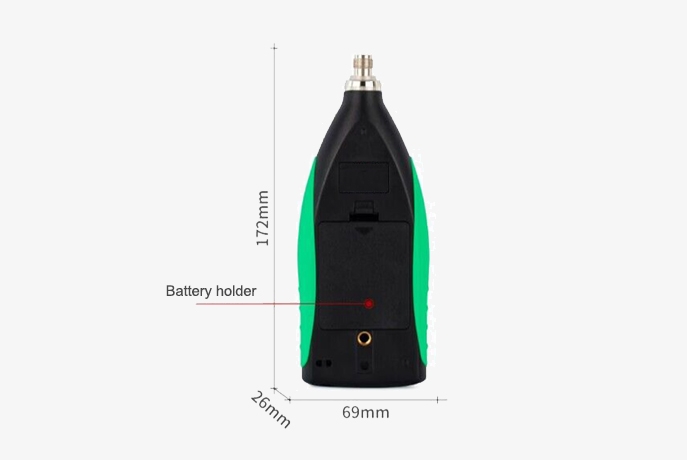
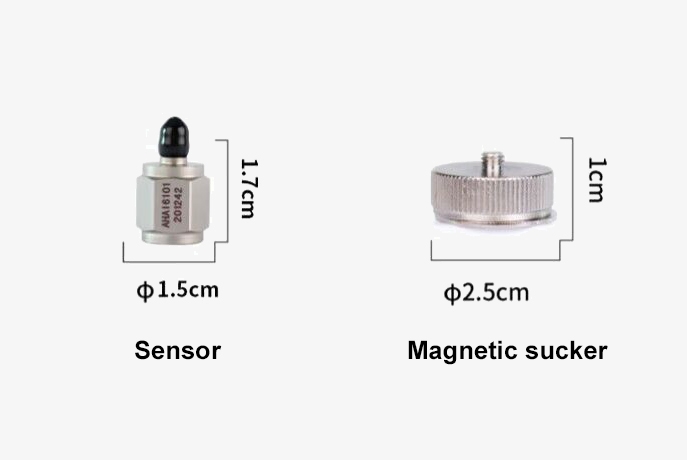
Details
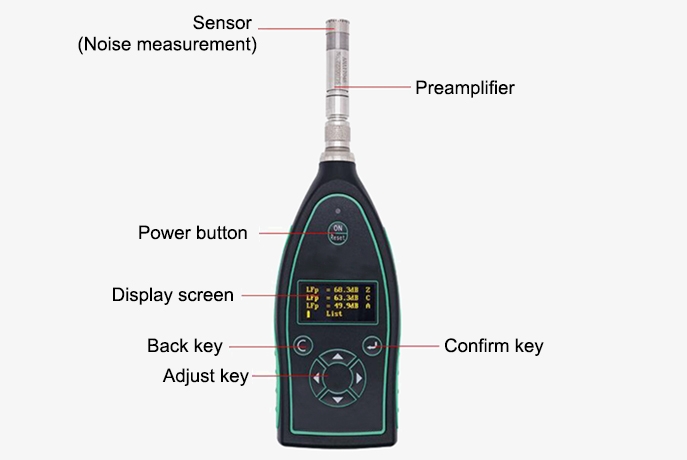
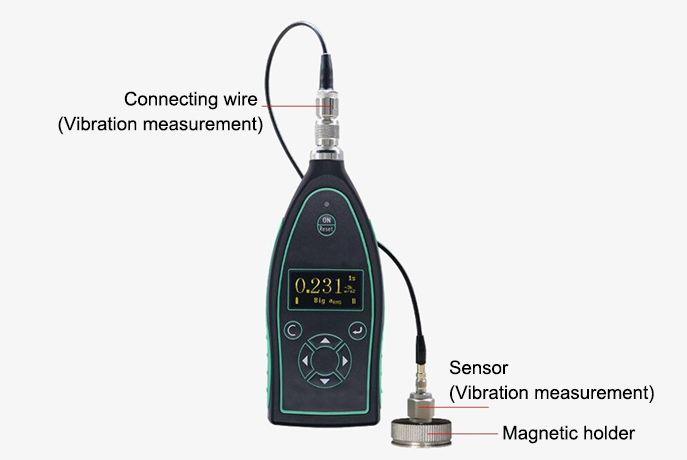
Packing List
- 1 x Sound level meter
- 1 x Inspection certificate
- 1 x Configuration list
- 1 x Certificate of conformity
- 1 x Windproof ball
- 1 x Power adapter and connecting cable
- 1 x U disk
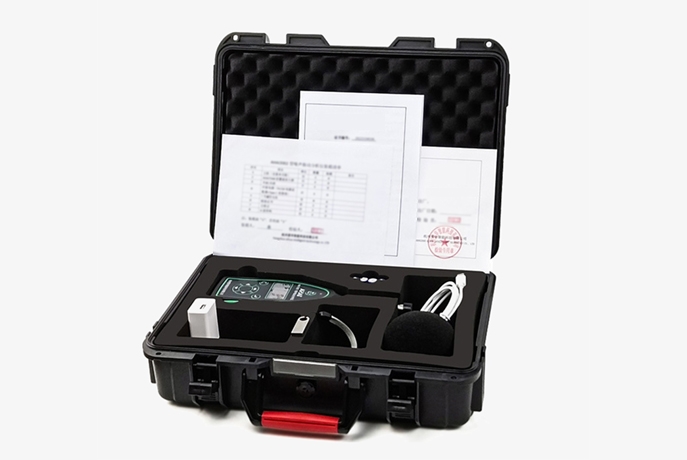
Q1: What is a noise detector?
A1: Noise tester is an instrument used for noise detection and testing in public places such as work sites and squares. Factory noise monitoring Noise pollution is one of the environmental pollutions that have a greater impact. Higher decibel noise can even cause serious damage to people's eardrums and cause deafness. The application of the noise tester can provide the decibel that the noise reaches in order to take relevant measures to control and reduce the noise. The measurement unit of the sound level is decibels. The professional noise tester has a highly sensitive sensor, high accuracy, and a wide range of applications. It can be widely used for noise measurement in various environments. Sound level measuring instrument, collectively referred to as sound level meter.
Q2: What does a sound level meter measure?
A2: A sound level meter measures the intensity of sound, typically expressed in decibels (dB), to quantify the level of noise in an environment. It uses a microphone to capture sound waves, which are converted into electrical signals that are analyzed and displayed as decibel levels. Sound level meters are often used to assess environmental noise, workplace safety, and product compliance with noise regulations. They may also incorporate frequency weighting (A, B, or C) to match human hearing perception and time weighting (fast or slow) to capture fluctuating noise accurately.
Q3: How big is the decibel scale?
A3: Sound is measured in decibels (dB). Whispering is about 30 decibels, normal conversation is about 60 decibels, and motorcycle engines run at about 95 decibels. Noise above 70 decibels for long periods of time may begin to damage your hearing. Loud noises above 120 dB can cause immediate damage to your ears.
Tips: how does a two in 1(noise and vibration measurement) sound level meter work?
A two-in-one noise and vibration measurement sound level meter works by combining two key measurement functions—sound (noise) level and vibration—in a single device. For noise measurement, the device uses a microphone to detect sound waves in the environment, which it converts into electrical signals. These signals are then processed and displayed as decibel (dB) levels, which indicate the intensity of the sound. The device may also include features like frequency weighting (A, B, or C) and time weighting (fast or slow) to provide more accurate readings based on the nature of the sound being measured.
For vibration measurement, the device is equipped with an accelerometer that detects mechanical movements or vibrations in a surface or object. The accelerometer senses the acceleration of the vibrating object and translates this into an electrical signal, which the device processes and displays in units such as meters per second squared (m/s²) or g-force (g). Combining both functions in a single unit allows users to monitor both environmental noise and equipment vibration simultaneously, making it useful in industries where both parameters are critical for safety and performance evaluations.
Thank you for buying industrial test and measurement equipment on SISCO.com, all products sold by SISCO and the partner cover a 12 months warranty, effective from the date of receiving the products.
What is covered?
SISCO is responsible for providing free spare parts, and free technical support to assist the customer to repair the defective products until the problem is solved.
What is not covered?
- Product purchased from anyone other than a SISCO store or a SISCO authorized reseller.
- Expendable parts.
- Routine cleaning or normal cosmetic and mechanical wear.
- Damage from misuse, abuse or neglect.
- Damage from use of parts other than SISCO approved.
- Damage from use outside the product’s usage or storage parameters.
- Damage from use of parts not sold by SISCO.
- Damage from modification or incorporation into other products.
- Damage from repair or replacement of warranted parts by a service provider other than a SISCO authorized service provider.
- Damage caused by the application environment not meeting the product usage requirements and the failure to perform preventive maintenance.

